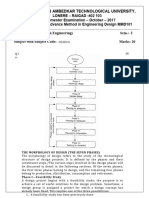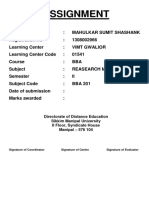Engineering Design Process: Generic Inputs, Tasks & Outputs Phase 1: Problem Definition
Uploaded by
Ahmad Rifky AzisEngineering Design Process: Generic Inputs, Tasks & Outputs Phase 1: Problem Definition
Uploaded by
Ahmad Rifky AzisEngineering Design Process: Generic Inputs, Tasks & Outputs
Phase 1: Problem Definition
Inputs Tasks Outputs
Entry Materials (possibly including any of): ● Establish qualitative and quantitative criteria ● Clarified problem statement:
● initial problem statement (Know/Need to Know, Criteria Tree) We as ____ seek to ____ in order to ____ for ____
● known criteria and constraints ● Identify constraints .
● Prioritize criteria (Pairwise Comparison) (Identify: role, problem, major criteria, stakeholders/
● stakeholders context)
● situational context ● Clarify problem in light of context and ● Criteria for success (qualitative and
stakeholders (Know/Need to Know Chart) quantitative)
● Establish metrics (Use-Value Analysis) ● Constraints
● Understand Relevant Science and Math ● Metrics
● Stakeholders
(Note: students should not consider these products
finalized and should revisit them throughout the
project)
Phase 2: Design Exploration
Inputs Tasks Outputs
● Clarified problem statement ● Determine necessary system functions (Black Box ● List of required functions
● Criteria, constraints, metrics, and Modeling, Reverse Engineering, Action-Function Chart) ● Preliminary design selection
stakeholders ● Develop performance targets (Competitor ● Criteria, constraints, and metrics
Benchmarking)
● Generate design alternatives (Brainstorm, Mind-Map,
Concept Sketching, Gallery Walk, Research, Patent
Search, Function-Means Tree, Morphological Chart)
● Compare design alternatives to criteria and
constraints (modeling/ testing)
● Proof of Concept (mockups, component testing)
● Analyze and consider tradeoffs
● Evaluate design alternatives and select design
(Pugh Chart, Decision Matrix, Two-Axis Comparison)
© 2017 Knowles Teacher Initiative. All Rights Reserved
Phase 3: Design Optimization
Inputs Tasks Outputs
● Preliminary design selection ● Develop Prototype ● Detailed final design (drawing, model,
● Prioritized criteria, constraints, metrics, ● Optimize: Build, Test, Verify, Refine (simulation, explanation, etc.)
stakeholders inquiry) ● Functional prototype
● List of required functions ● Performance specifications from testing,
modeling, etc. to show how well design/
prototype meets criteria/ constraints/ functions
Phase 4: Communicate Solution
Inputs Tasks Outputs
● Detailed Final Design ● Document the final design ● Technical Report possibly including:
● Prepare a report and/or presentation for ○ Technical drawings and design details
stakeholders ○ Fabrication specifications
● Final Presentation
(Students should be aware of desired audience and
outcome of the specific type of product requested.)
© 2017 Knowles Teacher Initiative. All Rights Reserved
You might also like
- W 3.1 - CH 2.2 Design Process StrategiesNo ratings yetW 3.1 - CH 2.2 Design Process Strategies38 pages
- SEHH2248 - Group Project Guidelines (202425S2)(1)No ratings yetSEHH2248 - Group Project Guidelines (202425S2)(1)2 pages
- MEE 513 (Mechanical Engineering Design II) Part 1No ratings yetMEE 513 (Mechanical Engineering Design II) Part 129 pages
- BE 1602 Engineering Practice Artefact Requirements and TestingNo ratings yetBE 1602 Engineering Practice Artefact Requirements and Testing37 pages
- Capstone Graduate Attributes Rubrics 2023 24 PDFNo ratings yetCapstone Graduate Attributes Rubrics 2023 24 PDF8 pages
- Higher Nationals Assignment Brief - BTEC (RQF)No ratings yetHigher Nationals Assignment Brief - BTEC (RQF)8 pages
- Need Identification (Customer/Client Statement ?) Problem DefinitionNo ratings yetNeed Identification (Customer/Client Statement ?) Problem Definition15 pages
- Guidelines - EMEC-4969 - Degree-Projects - Sep15-2023No ratings yetGuidelines - EMEC-4969 - Degree-Projects - Sep15-202314 pages
- Engineering Exploration: First Year Engineering (All) 2018-19 Maharashtra Institute of Technology AurangabadNo ratings yetEngineering Exploration: First Year Engineering (All) 2018-19 Maharashtra Institute of Technology Aurangabad66 pages
- Design Process: (Material Developed by Project Lead The Way)No ratings yetDesign Process: (Material Developed by Project Lead The Way)20 pages
- Design Projects Guidelines 2013.23 SeptemberNo ratings yetDesign Projects Guidelines 2013.23 September21 pages
- Intro. To Aerospace Eng. Design: - IntroductionNo ratings yetIntro. To Aerospace Eng. Design: - Introduction41 pages
- EDP - 2 - Lecture 4 - Phases - of - Engineering DesignNo ratings yetEDP - 2 - Lecture 4 - Phases - of - Engineering Design14 pages
- Engineering Design Problem 2. Research and Gather Data 5. Develop Prototype/ModelsNo ratings yetEngineering Design Problem 2. Research and Gather Data 5. Develop Prototype/Models2 pages
- 07A 2016 Denver BEST TMI Engineering Design ProcessNo ratings yet07A 2016 Denver BEST TMI Engineering Design Process25 pages
- Conceptions of The Engineering Design Process: An Expert Study of Advanced Practicing ProfessionalsNo ratings yetConceptions of The Engineering Design Process: An Expert Study of Advanced Practicing Professionals30 pages
- Generalized Mechatronics Design Process:: Sequential Vs Concurrent DesignNo ratings yetGeneralized Mechatronics Design Process:: Sequential Vs Concurrent Design16 pages
- Activities Guide and Evaluation Rubric - Step 3 - Design Oriented To Objects and ComponentsNo ratings yetActivities Guide and Evaluation Rubric - Step 3 - Design Oriented To Objects and Components9 pages
- Design Functions and Solutions: Christopher Saldana, PH.DNo ratings yetDesign Functions and Solutions: Christopher Saldana, PH.D34 pages
- Difference Between Scientific Method and Engineering Method 1 1No ratings yetDifference Between Scientific Method and Engineering Method 1 125 pages
- Cassiolato - Systems of Innovation and DevelopmentNo ratings yetCassiolato - Systems of Innovation and Development16 pages
- Assignment: Directorate of Distance Education Sikkim Manipal University II Floor, Syndicate House Manipal - 576 104No ratings yetAssignment: Directorate of Distance Education Sikkim Manipal University II Floor, Syndicate House Manipal - 576 10410 pages
- Accountability and Performance: Evidence From Local GovernmentNo ratings yetAccountability and Performance: Evidence From Local Government18 pages
- Bio 301 - Quantitative Biology Course OutlineNo ratings yetBio 301 - Quantitative Biology Course Outline3 pages
- Twelve Tips For Getting Started Using Mixed Methods in Medical Education ResearchNo ratings yetTwelve Tips For Getting Started Using Mixed Methods in Medical Education Research6 pages
- Research Design-Research Locale - Population and Sample-Sampling MethodNo ratings yetResearch Design-Research Locale - Population and Sample-Sampling Method9 pages
- (Ebook) Schaum's Outline of Statistics and Econometrics by Dominick Salvatore, Derrick Reagle ISBN 9780071348522, 0071348522 - The ebook is available for instant download, read anywhere100% (1)(Ebook) Schaum's Outline of Statistics and Econometrics by Dominick Salvatore, Derrick Reagle ISBN 9780071348522, 0071348522 - The ebook is available for instant download, read anywhere59 pages
- Statistic in Language Teaching: 1 Group Kurnia Zuul Fikri Daru Wiwi MarsaNo ratings yetStatistic in Language Teaching: 1 Group Kurnia Zuul Fikri Daru Wiwi Marsa17 pages
- Unit Iv. Lesson I Methodology: Cagayan State University-Lal - Lo CampusNo ratings yetUnit Iv. Lesson I Methodology: Cagayan State University-Lal - Lo Campus8 pages
- Pengaruh Saluran Distribusi, Harga Dan Promosi Terhadap Volume Penjualan Pada Home Industri Tempe Putra KL Kecamatan Socah Tahun 2016No ratings yetPengaruh Saluran Distribusi, Harga Dan Promosi Terhadap Volume Penjualan Pada Home Industri Tempe Putra KL Kecamatan Socah Tahun 201615 pages
- Math401E, Ch3, Mortality Table, Emad Salem-EditedNo ratings yetMath401E, Ch3, Mortality Table, Emad Salem-Edited19 pages
- Assessing New Product Development Success Factors in The Thai Food IndustryNo ratings yetAssessing New Product Development Success Factors in The Thai Food Industry23 pages
- Yambao - Guidance Program Evaluation ReportNo ratings yetYambao - Guidance Program Evaluation Report17 pages
- Difference Between Qualitative and QuantitaveNo ratings yetDifference Between Qualitative and Quantitave13 pages

























































































